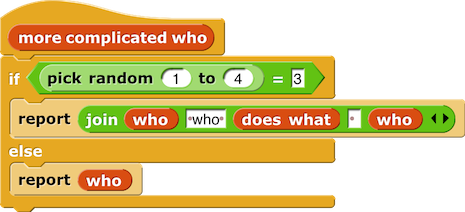Page 2: Checking the Player’s Guess
Unit 2, Lab 1, Page 2
On this page, you’ll continue to develop your number guessing game to accept player guesses until the player guesses correctly.
You’ll want the computer to ask players to guess again and again until they guess correctly. To do that, you will use the  block.
block. Repeat until is a loop (just like repeat, forever, and for) but also a conditional (like if and if else). It repeats until a certain condition is met. For this program, the code should repeat until the player’s answer equals the secret number.
You learned about loops on Unit 1 Lab 3 Page 6: Looping with a Counter.
You’ve seen conditionals on Unit 1 Lab 2 Page 5: Adding Variety to Gossip and Unit 1 Lab 5 Page 2: Sprite Following a Sprite.
- Use
repeat untilto ask the player ( ) to guess the secret number until their
) to guess the secret number until their  equals the secret number.
equals the secret number.
- Drag the secret number variable out of the
script variablesblock to use it. - The
askandanswerblocks go together. If you useaskto ask a question, the user’s answer will be reported byanswer.
The code  would be written as
would be written as
DISPLAY("Why did the chicken cross the road?")
userResponse ← INPUT()
or  .
.
Notice that the procedure INPUT() accepts the value from the user and returns that input value, which is then assigned to the variable userResponse with the ← syntax. In Snap!, this is just like how answer accepts a value from the user and reports it, and that report is what the computer sets the variable user response to.
- After the player guesses the secret number, make the computer congratulate the player.
- Test and debug. Take turns playing the game, and fix any problems with the code before moving on.
Repeat until makes its decision based on the output of a hexagonal predicate block.
: Predicate and Boolean value
The word Boolean is capitalized because it’s named after a person, George Boole, who invented the branch of mathematics dealing with Boolean operations (such as and, or, and not).
A predicate is a hexagon-shaped reporter that asks a true/false question such as these examples:


Predicates report a Boolean value (either  or
or  ).
).
Predicates fit into a hexagonal input slots of conditionals, such as in  and
and  . Predicates help conditionals decide when to do something.
. Predicates help conditionals decide when to do something.
The if and if-else blocks are called conditionals because they control the code based on a true-or-false condition.
- When the computer congratulates the player for guessing correctly, have the computer say the number. For example, it might say, “You guessed it! My secret number was 7.”
Use join to merge the text “You guessed it! My secret number was” with the value of the secret number variable.
